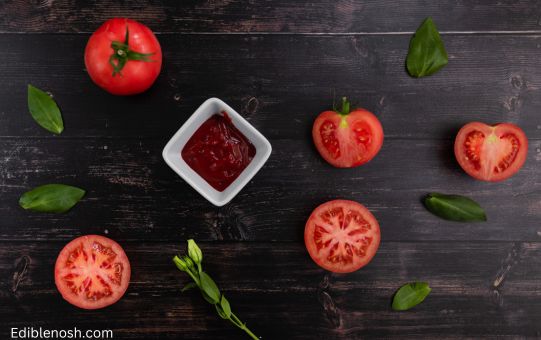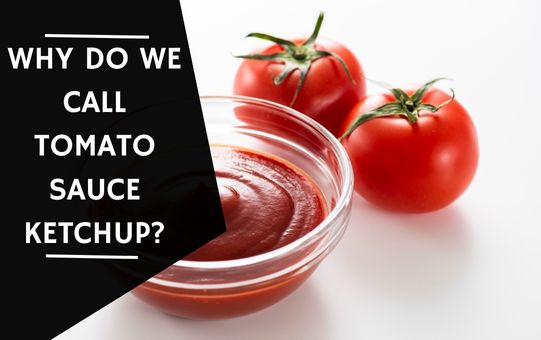Everyone knows what ketchup is, correct? Tomato sauce, you say? Who decided upon the name “ketchup”? Why Do We Call Tomato Sauce Ketchup?
Ketchup, a tomato-based sauce with various spices and seasonings, derives its name from the Chinese words “kôe-chiap” or “kê-tsiap,” which refer to a fermented fish sauce. In 1869, H.J. Heinz began mass-producing tomato ketchup, which became a worldwide staple after gaining popularity in the 1800s.
Here is a summary of the history and development of this popular condiment.
Contents
- Why Do We Call Tomato Sauce Ketchup Matter?
- The Origins of Ketchup
- The Rise of Tomato Ketchup
- The Industrialization of Ketchup
- The Globalization of Ketchup
- The Future of Ketchup
- The Nutritional Value of Ketchup
- How Ketchup is made?
- The Storage and Shelf Life of Ketchup
- Conclusion
- FAQs | Why Do We Call Tomato Sauce Ketchup?
Why Do We Call Tomato Sauce Ketchup Matter?
The word “ketchup” actually comes from the Hokkien Chinese word “kê-tsiap,” which means a sauce made from fermented fish. The sauce was brought to Europe by Dutch traders in the late 17th century and was initially made from a variety of ingredients, including mushrooms, walnuts, and anchovies.
Tomatoes were introduced to Europe in the 16th century but were initially considered poisonous and were used primarily as decorative plants. It wasn’t until the 18th century that tomatoes were widely accepted as a food item. In the late 1700s, recipes for tomato-based ketchup began to appear, and by the mid-1800s, tomato ketchup had become the most popular variety.
Today, “ketchup” typically refers specifically to the tomato-based sauce, although other varieties, such as mushroom ketchup or banana ketchup, also exist. So, while the word “ketchup” originally referred to a sauce made from fermented fish, it has evolved over time to become synonymous with tomato sauce.
The Origins of Ketchup
The word “ketchup” has a long and complex history. It is thought to have originated from the Chinese word “kôe-chiap” or “kê-tsiap,” which was a brine made from pickled fish. This sauce was popular in southern China and was eventually introduced to the British colonies in the late 1600s.
From there, the recipe for ketchup began to evolve and change. It was made with a variety of ingredients, including anchovies, mushrooms, and walnuts. Eventually, tomatoes were added to the mix and the ketchup we know today began to take shape.
Read Also: Why Did My Tomato Sauce Separate?
The Rise of Tomato Ketchup
Tomatoes were first introduced to Europe in the late 1500s, but they were not widely cultivated or used in cooking until the 1800s. Once they became more readily available, people started experimenting with using them in a variety of dishes.
One of the first recorded recipes for tomato ketchup was published in 1812 by an American cookbook author named James Mease. His recipe called for tomatoes, spices, and brandy to be boiled together and then strained to create a smooth sauce.
Tomato ketchup quickly gained popularity and became a staple condiment in many American and European households. It was used on a variety of dishes, including meats, vegetables, and even ice cream.

The Industrialization of Ketchup
As ketchup became more popular, commercial production of the sauce began to rise. The first company to mass-produce ketchup was a firm called H.J. Heinz, which was founded in 1869.
Heinz’s ketchup was made with high-quality ingredients and was free of preservatives and artificial flavors. This helped to establish the company as a leader in the ketchup industry and cemented ketchup’s place as a household staple.
The widespread production and distribution of ketchup also helped to standardize the recipe and make it more consistent from one batch to the next. This made it easier for people to enjoy the same flavors and textures no matter where they were.
The Globalization of Ketchup
As ketchup became more popular and widely available, it started to be embraced by cultures around the world. It was introduced to new countries and regions and began to be used in a variety of local dishes.
For example, in many Asian countries, ketchup is used as a key ingredient in sweet and savory dishes. In the Philippines, ketchup is often used in a dish called “adobo,” which is made with chicken or pork that is simmered in a mixture of vinegar, soy sauce, and ketchup.
In other parts of the world, ketchup is used as a condiment on traditional dishes such as fries, hot dogs, and burgers. It has become a global condiment, enjoyed by people of all ages and backgrounds.
The Future of Ketchup
As the popularity of ketchup continues to grow, it is likely that we will see even more creative uses for this versatile sauce. With the rise of plant-based diets, there is also an increasing demand for vegetarian and vegan alternatives to traditional ketchup.
Many companies are now offering plant-based ketchup options made with ingredients such as tomatoes, beets, and even fruit. These alternative ketchup options allow people following plant-based diets to enjoy the same flavors and textures as traditional ketchup but with a more sustainable and animal-friendly twist.
Another trend that is gaining popularity is the use of locally sourced and artisanal ketchup. These small-batch ketchup makers are using locally grown ingredients and unique flavor combinations to create a more artisanal and gourmet version of the classic condiment.
The Nutritional Value of Ketchup
Ketchup is a popular condiment that is often used to add flavor and moisture to a variety of dishes. While it is tasty, it is important to be aware of the nutritional value of ketchup. Here is a breakdown of the nutrients found in a one-tablespoon serving of ketchup:
| Nutrient | Amount |
|---|---|
| Calories | 20 |
| Fat | 0g |
| Sodium | 160mg |
| Carbohydrates | 5g |
| Sugar | 4g |
| Protein | 0g |
As you can see, ketchup is relatively low in calories and fat, but it does contain a decent amount of sodium and sugar. It is important to keep this in mind if you are watching your salt or sugar intake.
While ketchup can be enjoyed in moderation as a condiment, it is not a significant source of essential nutrients. It is important to include a variety of nutritious foods in your diet in addition to ketchup.
How Ketchup is made?
Ketchup is a condiment made from tomatoes, vinegar, and a blend of spices and seasonings. Here is a general overview of the process of making ketchup:
- Tomatoes are harvested and sorted for quality.
- The tomatoes are then crushed and heated to remove the skins and seeds.
- The remaining tomato pulp is combined with vinegar, sugar, and a blend of spices, which can include onion, garlic, and celery seed.
- The mixture is then cooked down and simmered until it reaches the desired consistency.
- The ketchup is then strained to remove any remaining solids and bottled or canned for distribution.
Some commercial producers may use additional ingredients, such as preservatives or artificial flavors, to extend the shelf life of the ketchup. The specific ingredients and proportions used in the recipe can vary from one ketchup maker to another, giving each brand its own unique flavor profile.

The Storage and Shelf Life of Ketchup
Ketchup is a popular condiment that is often used to add flavor to a variety of dishes. Proper storage and handling can help to extend the shelf life of ketchup and ensure that it stays fresh and safe to use. Here are a few tips for storing and maintaining the shelf life of ketchup:
- Keep ketchup in a cool, dry place. Ketchup is best stored in a pantry or cupboard that is away from direct light and heat. This can help to prevent the sauce from spoiling or going bad too quickly.
- Refrigerate opened ketchup. Once a bottle of ketchup has been opened, it is best to transfer it to the refrigerator to help extend its shelf life. This is especially important during the warmer months when the risk of bacterial growth is higher.
- Check the expiration date. Ketchup typically has a shelf life of about one year when it is unopened. Once it has been opened, the shelf life will depend on the specific brand and the storage conditions. It is important to check the expiration date on the bottle and discard any ketchup that is past its expiration.
- Follow proper food safety guidelines. It is important to handle ketchup safely to prevent the risk of foodborne illness. This includes washing your hands before handling the ketchup, using a clean spoon or spatula to serve it and properly sealing the bottle after use.
By following these guidelines, you can help to extend the shelf life of your ketchup and ensure that it stays fresh and safe to use.
Read Also: Why Cook Tomato Sauce Long?
Conclusion
It is clear that ketchup is a beloved condiment that will continue to evolve and be enjoyed by people around the world for many years to come. Whether you prefer traditional ketchup, a plant-based version, or an artisanal twist on the classic sauce, there is a ketchup option out there for everyone.
FAQs | Why Do We Call Tomato Sauce Ketchup?
Here are five FAQs for the topic of “Why Do We Call Tomato Sauce Ketchup?”:
What Is The Origin Of The Word “Ketchup”?
The word “ketchup” is thought to have originated from the Chinese word “kôe-chiap” or “kê-tsiap,” which was a brine made from pickled fish. This sauce was popular in southern China and was eventually introduced to the British colonies in the late 1600s.
When Was Tomato Ketchup First Created?
The first recorded recipe for tomato ketchup was published in 1812 by an American cookbook author named James Mease. His recipe called for tomatoes, spices, and brandy to be boiled together and then strained to create a smooth sauce.
Who Was The First Company To Mass-Produce Ketchup?
The first company to mass-produce ketchup was H.J. Heinz, which was founded in 1869. Heinz’s ketchup was made with high-quality ingredients and was free of preservatives and artificial flavors.
Is Ketchup Popular Worldwide?
Yes, ketchup has become a global condiment that is enjoyed by people of all ages and backgrounds. It is used as a condiment on traditional dishes such as fries, hot dogs, and burgers, and is also used as a key ingredient in sweet and savory dishes in many Asian countries.
Are There Vegetarian Or Vegan Alternatives To Ketchup?
Yes, there are a number of plant-based ketchup options available on the market. These options are made with ingredients such as tomatoes, beets, and fruit, and allow people following plant-based diets to enjoy the same flavors and textures as traditional ketchup.

